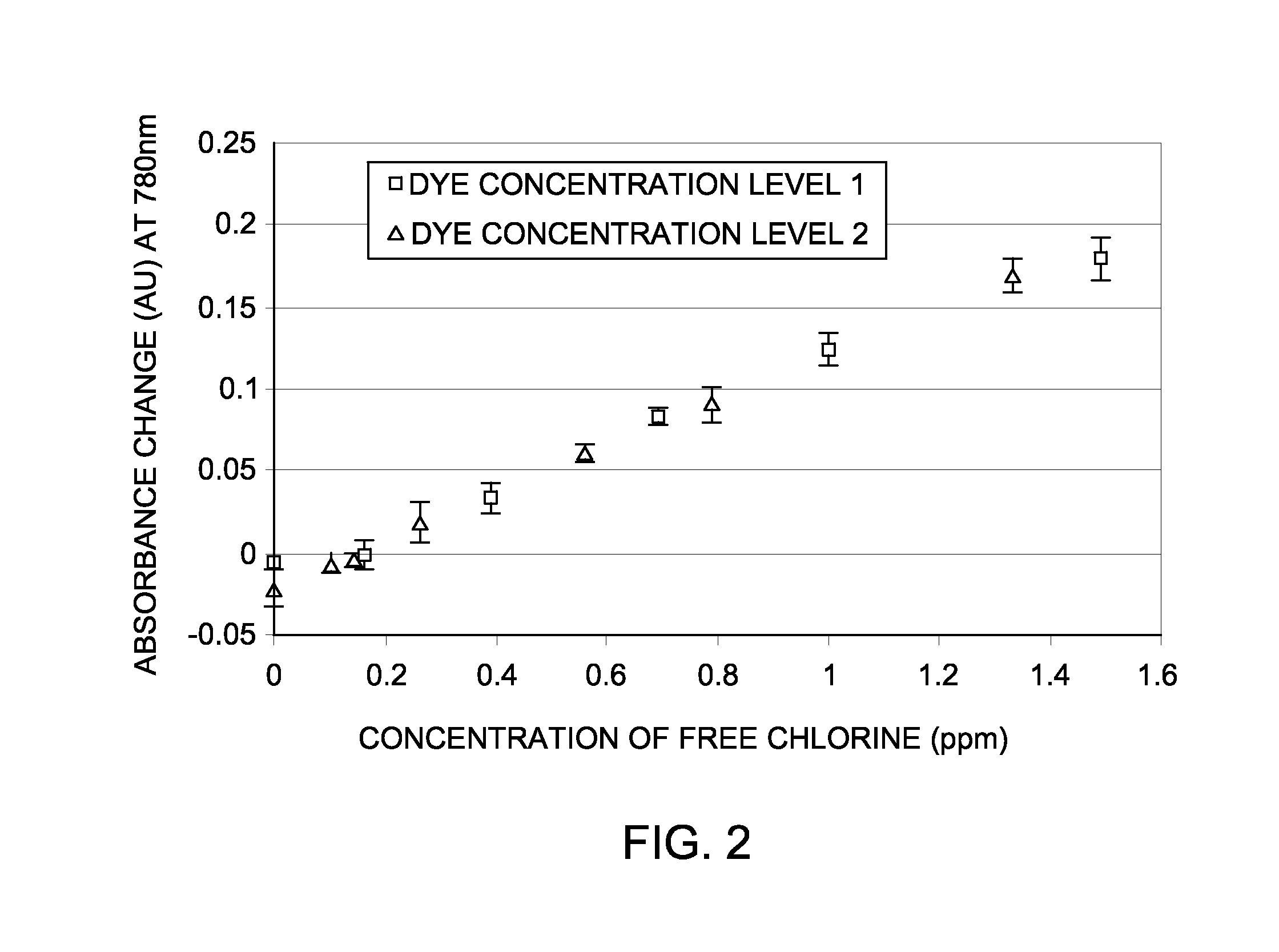Methods of using cyanine dyes for the detection of analytes
a technology of cyanine dye and analytes, applied in the field of detection of analytes, can solve the problems of fluid flow, and affecting the heat transfer rate of system equipment,
- Summary
- Abstract
- Description
- Claims
- Application Information
AI Technical Summary
Benefits of technology
Problems solved by technology
Method used
Image
Examples
example 1
Cyanine Dyes for F—Cl Detection Using Aqueous IR-783
[0044]There are number of scenarios in which free chlorine (F—Cl) and / or total chlorine have be monitored at very low concentration. For example, reverse osmosis (R.O.) is a technique for removing dissolved solids (salts) from filtered raw water. It is used in a variety of industries to condition water for plant use, or as a step in the demineralization process. The continued performance of a reverse osmosis system depends upon the condition of the semipermeable membrane. When free chlorine concentration is higher than about 0.02 ppm, it can degrade many membrane materials, so the raw water is often dechlorinated prior to entering the R.O. system.
[0045]Since raw water can contain either free or total chlorine, it is important to determine which form of chlorine is present, and select the right chlorine monitoring equipment. Accordingly, supersensitive detection methods are highly desired for the protection of reverse osmosis membra...
example 2
Cyanine Dyes for F—Cl Detection using IR-783 in Solid pHEMA Film
[0048]Applicants have also found that when IR-783 is incorporated into a film, the response to free-chlorine is identical to that of aqueous IR-783. In this example, the film was made from pHEMA stock in 2-methoxyethanol (or DM, or DM / PM mixture) containing IR-783 (5 mg to 20 mg per gram of pHEMA stock) by flow-coating. DM is di(ethylene glycol) monomethyl ether and PM is 1-Methoxy-2-Propanol. The dry film thickness could be from about 1 μm to about 20 μm. The film was assembled and exposed to standard F—Cl solutions and a TrueSense PWA reader was used to acquire the response. FIG. 2 shows the calibration curve obtained for IR-783 in pHEMA film at 780 nm. FIG. 2 was obtained by subtracting the absorbance of a samples containing free chlorine at known concentrations from the absorbance of a sample containing no free chlorine. In FIG. 2, dye concentration level 1 is 10 mg per 10 g of ink, and dye concentration level 2 is ...
example 3
Cyanine Dyes for T-Cl by IR-783 with KI
[0049]In this example, the total chlorine (T-Cl) is calculated using cyanine indicator dye, more specifically IR-783 in aqueous phase. T-Cl, the sum of both free and combined chlorine, can be determined by the DPD method after the addition of catalytic amounts of potassium iodide (KI) to the aqueous solution sample. In the DPD method, DPD (N,N-diethyl-p-phenylenediamine) is oxidized by chlorine, causing a magenta (red) color. The intensity of color is directly proportional to the chlorine concentration. For total chlorine, potassium iodide is added to the reaction to determine combined available chlorine forms and total chlorine. Chloramines oxidize the iodide to iodine; then the liberated iodine reacts with DPD to form the magenta color.
[0050]Monochloramine and dichloramine are very slowly reacts with cyanine dyes at near neutral pH. To quantify these species, the tests in this example were performed with iodide as catalyst. The iodide reacts ...
PUM
| Property | Measurement | Unit |
|---|---|---|
| thickness | aaaaa | aaaaa |
| time | aaaaa | aaaaa |
| wavelengths | aaaaa | aaaaa |
Abstract
Description
Claims
Application Information
 Login to View More
Login to View More - R&D
- Intellectual Property
- Life Sciences
- Materials
- Tech Scout
- Unparalleled Data Quality
- Higher Quality Content
- 60% Fewer Hallucinations
Browse by: Latest US Patents, China's latest patents, Technical Efficacy Thesaurus, Application Domain, Technology Topic, Popular Technical Reports.
© 2025 PatSnap. All rights reserved.Legal|Privacy policy|Modern Slavery Act Transparency Statement|Sitemap|About US| Contact US: help@patsnap.com



